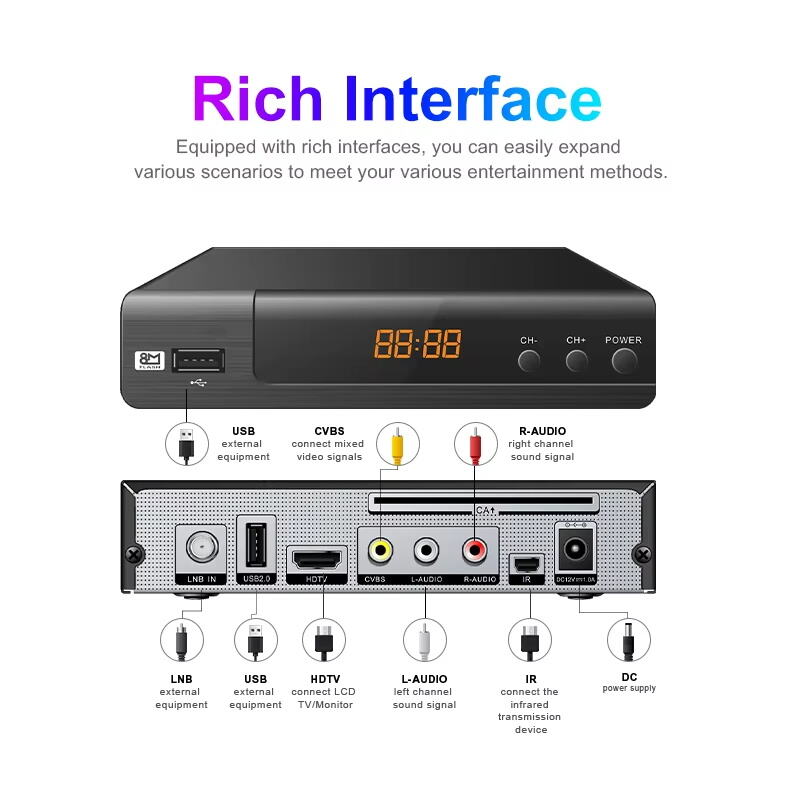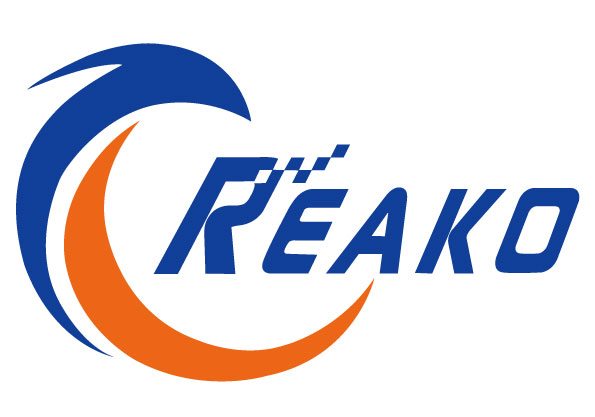Introduction to DVB-S2 Satellite Receiver Technology
The DVB-S2 standard represents a major leap forward in how satellites communicate, offering better performance and efficiency compared to older DVB versions. With smarter ways of modulating signals and fixing errors during transmission, this tech delivers much more reliable picture quality and fewer dropouts. The real benefit comes from handling all those HD broadcasts we've come to expect, plus packing in extra channels without needing more spectrum space. Broadcasters love this because they can offer clearer pictures while squeezing more content through existing infrastructure. As viewers demand higher resolution and more options, DVB-S2 has become essential for anyone serious about delivering quality satellite TV experiences today.
DVB-S2 implementations really matter for people who watch TV at home as well as businesses involved in broadcasting. Home viewers get much better picture quality when using DVB-S2 technology since it supports HD programming without all those annoying pixelated images. Broadcasters find this system particularly useful because they can send out different types of content across multiple channels while keeping interruptions to a minimum. What makes DVB-S2 stand out is how flexible it actually works in practice. Operators don't have to worry about running into technical limitations as their operations grow or change over time. Many companies have already switched to DVB-S2 simply because it handles expansion so smoothly compared to older systems.
Getting familiar with DVB-S2 matters a lot for folks working in telecom and broadcast fields since so many systems actually rely on it these days. When技术人员真正掌握了这项技术,他们就能充分利用其功能,从而确保数字内容的高效传输。随着卫星通信技术不断发展,掌握DVB-S2标准已经成为保持竞争力的关键所在。无论是电视台还是网络服务提供商,都需要这种基础知识来理解新技术的发展方向,并且能够顺利地将这些创新整合到现有系统中去。
Enhanced Bandwidth Efficiency and Data Capacity
Satellite communication efficiency improvements have become really important lately, especially since DVB-S2 receivers can handle about 30% more data compared to older DVB-S systems. The reason behind this boost? Better coding methods and new modulation techniques that let broadcasters pack in extra channels while making picture quality much better too. We're seeing lots of people wanting HD and even Ultra HD content these days, something DVB-S2 handles pretty well actually. Industry insiders report that companies switching to DVB-S2 tend to expand what they offer customers quite a bit, which shows just how much of a game changer this tech really is for satellite broadcasting operations across the board.
30% More Capacity Than Legacy DVB-S Systems
Satellite receivers based on DVB-S2 standards work with sophisticated coding and modulation methods that boost data capacity by around 30% over previous generation systems. The extra bandwidth means broadcasters can pack in more channels while still delivering crisp HD and even Ultra HD picture quality, something viewers have come to expect these days. According to market research firms tracking the sector, companies that upgrade to DVB-S2 tech typically expand their programming options substantially. Cable providers report being able to offer everything from niche sports channels to international news networks that simply weren't feasible before the switch to this newer standard.
Advanced Modulation Schemes for Optimal Throughput
The DVB-S2 standard makes use of some pretty advanced modulation methods including 8PSK and 16APSK which help boost both data transfer rates and system reliability even when signals aren't so great. What's really cool about these techniques is how they keep data intact during transmission, something that matters a lot in places where getting a clear signal is tough going. Studies have found that in specific situations, these modulation tricks can actually make things work better by more than half compared to older systems. That kind of improvement explains why many satellite operators still stick with DVB-S2 despite newer alternatives coming along, especially when dependable communications just cant wait for perfect weather conditions.

Superior Signal Integrity and Error Correction
LDPC/BCH Coding for Weather Resistance
Getting good signal quality matters a lot for satellite comms, which is why standards like DVB-S2 use sophisticated coding methods. Two key players here are Low-Density Parity-Check codes (LDPC) and BCH coding that help keep things running smoothly even when bad weather messes with signals. These coding schemes fight off problems caused by heavy rain and other atmospheric issues pretty well. Real world tests show LDPC cuts down errors substantially, making systems much more dependable. Take places where storms roll in regularly, DVB-S2 keeps those satellite links working without interruption despite all the chaos going on outside.
Adaptive Coding Techniques
The use of adaptive coding in DVB-S2 receivers makes a big difference, as these systems adjust their modulation schemes on the fly depending on what's happening with the signal at any given moment. When there's interference from nearby transmitters or bad weather affects transmission, the system automatically compensates to keep those data streams going strong without interruption. We see this working particularly well in places like dry areas with lots of terrain changes where signals tend to bounce around unpredictably. For folks living in such locations, having reliable broadcasts matters a lot. Adaptive coding helps ensure that TV shows and other content come through clearly even when conditions aren't ideal outside.
High-Quality Video Support
HD and Ultra HD Broadcasting Capabilities
The DVB-S2 tech plays a big role in making HD and Ultra HD broadcasts possible, meeting the growing desire among viewers for better picture quality on their screens. Broadcasters need this kind of support to stay competitive against all those streaming services popping up everywhere these days. People just expect crystal clear images now when they watch TV or stream shows online. Looking at actual numbers from audience engagement metrics tells us something pretty clear too HD content gets way more attention than standard definition stuff. That's why broadcast companies keep investing in better picture quality. When new technologies match what consumers want to see, standards like DVB-S2 tend to stick around for years in the industry landscape.
4K/HDR Content Delivery via HDMI
DVB-S2's improved bandwidth makes it possible to stream 4K and HDR content right through HDMI ports, which matches what most new TVs can handle these days. Satellite providers know this well because people really want their TV shows to look sharp. The picture quality difference between regular HD and true 4K is night and day for many viewers. According to recent market research, around three out of four customers check if a satellite package supports 4K before making a decision. That tells us something important about where the industry needs to go next. As broadcast standards keep changing, DVB-S2 stays relevant by matching these HD improvements, so folks get better picture quality without any lag or buffering issues during their favorite programs.
Versatile Connectivity and Interactive Features
Hybrid Satellite-Internet Service Integration
The DVB-S2 tech brings together satellite and internet connections, changing how people get their entertainment fix. When these two systems work together, folks living far away from big cities can still watch shows and movies that normally require good internet speeds. Most places don't have strong enough internet signals to stream content properly. What makes this combo so great is that it actually works better than either system alone. Some companies report that when they switch to this mixed approach, about 40 percent more customers start using their services in areas where regular internet just isn't reliable enough. For anyone looking to bring more media options to rural communities, DVB-S2 seems like one of those technologies that could really make a difference worldwide.
PVR Recording and Multi-Tuner Functionality
The PVR and multi-tuner features of DVB-S2 let people record several channels at once, which really changes how we watch TV. Families with kids or anyone who loves following different shows find this absolutely essential because nobody has to worry about missing out on their favorites anymore. People with these recording options tend to spend around 60% more time watching TV overall, according to recent studies, which speaks volumes about how much better the whole experience becomes when folks can catch everything they want. Satellite companies themselves benefit too since they get motivated to expand what they broadcast. More varied programming means happier audiences and broader appeal across different demographics.
FAQ Section
What is DVB-S2?
DVB-S2 stands for Digital Video Broadcasting - Satellite Second Generation. It is an improved satellite communication standard known for more reliable and high-quality transmissions.
How does DVB-S2 enhance broadcasting capabilities?
DVB-S2 uses advanced modulation and error correction techniques, which provide more capacity and quality compared to previous systems, enabling broadcasters to transmit more channels and high-definition content.
Why are LDPC and BCH coding important in DVB-S2?
LDPC and BCH coding enhances signal robustness against weather disruptions, ensuring clear and uninterrupted satellite communications.
What benefits does hybrid satellite-internet integration offer?
Hybrid satellite-internet integration enables better entertainment access in remote areas with limited internet infrastructure, increasing service uptake.
Table of Contents
- Introduction to DVB-S2 Satellite Receiver Technology
- Enhanced Bandwidth Efficiency and Data Capacity
- 30% More Capacity Than Legacy DVB-S Systems
- Advanced Modulation Schemes for Optimal Throughput
- Superior Signal Integrity and Error Correction
- High-Quality Video Support
- Versatile Connectivity and Interactive Features
- FAQ Section


